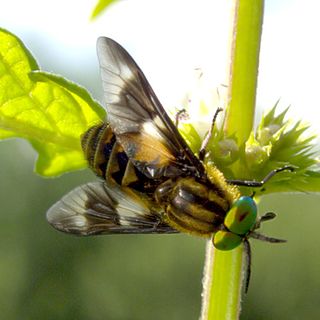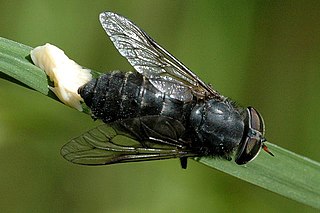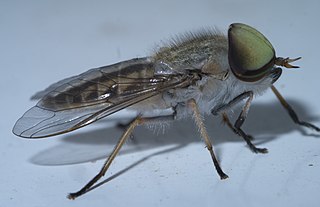
Horse-flies and deer flies are true flies in the family Tabanidae in the insect order Diptera. The adults are often large and agile in flight. Only female horseflies bite land vertebrates, including humans, to obtain blood. They prefer to fly in sunlight, avoiding dark and shady areas, and are inactive at night. They are found all over the world except for some islands and the polar regions. Both horse-flies and botflies (Oestridae) are sometimes referred to as gadflies.
Brennania is a genus of flies in family Tabanidae. It was originally known as Comops, created as a subgenus of Apatolestes by Brennan (1935). Philip (1941) then raised it to genus level, but renamed it to Brennania.

Superfamily Tabanoidea are insects in the order Diptera.

Hybomitra is a genus of horse flies in the family Tabanidae. There are at least 240 described species in Hybomitra.
Cornelius Becker Philip (1900–1987) was an American entomologist, noted for assigning comedic names to species he described.
Neochrysops is a genus of horse flies in the family Tabanidae.

Tabaninae is a subfamily in the family Tabanidae commonly known as horse flies. There are more than 3000 described species in Tabaninae.

Diachlorini is a tribe of horse flies in the family Tabanidae.

Tabanini is a tribe of horse and deer flies in the family Tabanidae. There are at least 220 described species in Tabanini.

Chrysopsinae is an insect subfamily in the family Tabanidae commonly known as deer flies or sheep flies and are bloodsucking insects considered pests to humans and cattle. They are large flies with large brightly-coloured compound eyes, and large clear wings with dark bands. They are larger than the common housefly and smaller than the horse-fly.
Atylotus tingaureus is a species of horse flies in the family Tabanidae.
Microtabanus is a genus of horse flies in the family Tabanidae. There is at least one described species in Microtabanus, M. pygmaeus.
Goniops chrysocoma is a species of fly found in North America. It is the only species in the genus Goniops, which is in the horse and deer flies family Tabanidae.

Pangoniinae is a subfamily of horse-flies in the order Diptera, containing at seven tribes and over 40 genera.
Betrequia is a genus of horse flies in the family Tabanidae.
Montismyia is a genus of horse flies in the family Tabanidae.
Cretotabanus is a genus of horse flies in the family Tabanidae.
Thaumastomyia is a genus of horse flies in the family Tabanidae.
Bouvieromyiini is a tribe of horse flies in the family Tabanidae.

Sphecodemyia is a genus of flies in the family Tabanidae.









